Apizaco, Tlaxcala 作者: 来源: 发布时间:2021-11-17
1.Population and Area
Pop: 81,565 (city)
Area: 9.05 km2 (city)
Elev: 2,424 masl
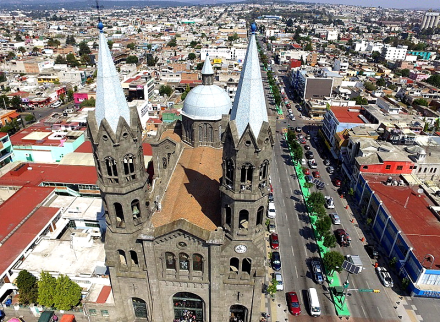
2. Natural geography
Nature and weather
Flora and fauna
Presents predominantly gallery tree vegetation on the banks of the Atenco, Zahuapan and Texcalac rivers, dominating the aile (alnus acuminata), associated with other species such as the willow (salix bonplandiana), the weeping willow (salix babilonica), the ash ( fraxinus uhdei), white poplar (populus alba) and tepozan (Buddleia cordata). In the flat parts of the municipality, the vegetation present is juniper forest, although very altered by agricultural activities and urban growth itself, the dominant species is the juniper (juniperus deppeana). The spaces left by the sabino are often occupied by herbs and shrubs, for example the pirul (schinus molle), the cat's claw (mimosa biuncifera), the white chicalote (argemone platyceras), the pulquero maguey (agave salmiana), the governor (brickelia veronicifolia), the capulín (prunus capuli) and several species of nopal (opuntia spp). In the urban and suburban flora, introduced species such as thunder, cypress, casuarina and eucalyptus abound.
Despite the growth and accelerated expansion of the urban area, in the territory of the municipality it is still common to find some type of wildlife such as: hare (lepus californicus), rabbit (silvilagus floridanus), opossum (didelphis marsupialis), rattlesnake (crotalus sp.), quail, and centzontle bird, also these zencoatl snake, armadillo, pheasant, roadrunner, coyote in some areas where there is not much deforestation and difficult access for man, cacomixtle or chiquina, squirrel and badger.
Köppen Classification: Oceanic Subtropical Highland Climate
The subtropical highland variety of the oceanic climate exists in elevated portions of the world that are within either the tropics or subtropics, though it is typically found in mountainous locations in some tropical countries. Despite the latitude, the higher altitudes of these regions mean that the climate tends to share characteristics with oceanic climates, though it also tends to experience noticeably drier weather during the "low-sun" season. In locations outside the tropics, other than the drying trend in the winter, subtropical highland climates tend to be essentially identical to an oceanic climate, with mild summers and noticeably cooler winters, plus, in some instances, some snowfall. In the tropics, a subtropical highland climate tends to feature spring-like weather year-round. Temperatures here remain relatively constant throughout the year and snowfall is seldom seen.Without the elevation, many of these regions would likely feature either tropical or humid subtropical climates.
The Köppen Climate Classification subtype for this climate is "Cwb". (Oceanic Subtropical Highland Climate).
The average temperature for the year in Apizaco is 56.8°F (13.8°C). The warmest month, on average, is May with an average temperature of 60.6°F (15.9°C). The coolest month on average is January, with an average temperature of 51.1°F (10.6°C).
The highest recorded temperature in Apizaco is 93.2°F (34°C), which was recorded in April. The lowest recorded temperature in Apizaco is 15.8°F (-9°C), which was recorded in January.
The average amount of precipitation for the year in Apizaco is 31.8" (807.7 mm). The month with the most precipitation on average is June with 6.0" (152.4 mm) of precipitation. The month with the least precipitation on average is February with an average of 0.3" (7.6 mm). In terms of liquid precipitation, there are an average of 96.8 days of rain, with the most rain occurring in July with 16.4 days of rain, and the least rain occurring in January with 1.4 days of rain.
http://www.weatherbase.com/weather/weather-summary.php3?s=929002&cityname=Apizaco%2C+Tlaxcala%2C+Mexico&units=
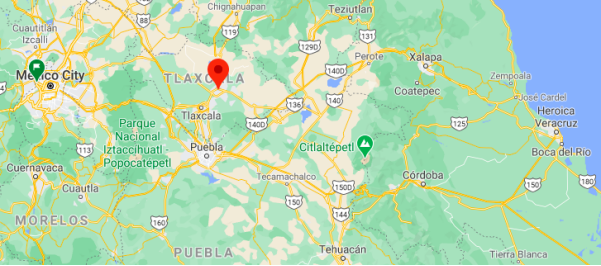
Getting there and around
Get there
By car – The cheapest way to get from Mexico City to Apizaco is to drive which costs $230 - $340 and takes 1h 42m. The distance between Mexico City and Apizaco is 103 km. The road distance is 132.4 km.
By bus – There are services departing from México TAPO and arriving at Apizaco via Pachuca. The journey, including transfers, takes approximately 4h 40m.
There is frequent bus service (about every 20 minutes, from early in the morning to late at night) to and from Puebla on ATAH, which has a station on Ave Zaragoza, south of Madero.
ATAH runs buses from Puebla to Apizaco from the main bus station CAPU. 1st bus leaves 06:00 hrs., and you have to be on that in order to get to the collectivo to la Malinche in time from Apizaco. Frequent buses back to Puebla all evening.
https://www.rome2rio.com/s/Mexico-City/Apizaco
Car Rental – To explore Mexico’s provincial towns and cities—including its beach locations and the scenery and attractions near them— consider renting a car for your visit. Having your own car will give you more flexibility than using public transport options and, in some cases, offer you access to places which are otherwise difficult to visit without the use of a car.
COVID19 – International entry into Mexico from United States
Allowed for: All visitors arriving by air. Mexico land borders are closed to non-essential travel
Restricted for: There are no current restrictions.
Get around
Local Buses – Local buses and mini-buses (combis or micros) are available locally for a fraction of the cost of a taxi around town. You need to speak Spanish to be able to ask for directions or ask the driver to tell you where to get off.
Taxis – Taxis in most of Mexico’s towns and cities are not metered, so agree your price before you get in. Taxi travel is very affordable in Mexico, in comparison to the USA, Canada and Europe, and so provides a viable means of public transportation in Mexico. Your hotel can arrange taxis for you; some post their rates on a board in the lobby; taxi hotel rates are usually higher than cabs you hail off the street. If you speak Spanish, you will have a distinct advantage and be able to negotiate a price with the driver.
Uber is expanding rapidly across Mexico and now offers services in cities across the country, including: Mexico City, Toluca, Cuernavaca, Puebla, Querétaro, León, Aguascalientes, San Luis Potosí, Guadalajara, Monterrey, Hermosillo, Tijuana, Mexicali, and Mérida. Uber has been adding Mexican cities to its network every year, check for availability when you arrive at your destination in Mexico.
Cabify and Didi are also developing and currently operate in cities including Mexico City, Toluca, Monterrey, Puebla, Querétaro and Tijuana. Check for availability in the city you are visiting.
These services offer people with smartphones a way to book a cab through a mobile app for a pre-agreed price. Fares are comparable with Sitio type cabs, and sometimes trade at a premium to this when local demand increases.
https://www.mexperience.com/transport/taxi-travel-in-mexico/#51
3. ECONOMY
GDP: 50,058 M MXN (2010,Tlaxcala-Apizaco metro área)
https://imco.org.mx/ciudades2010/ciudades/45_Tlaxcalaapizaco.html
4. Industry characteristics
The main industrial sectors in Apizaco (based on total gross production) in 2014 were Manufacturing Industries ($ 9.74M MX), Retail Trade ($ 713k MX), Wholesale Trade ($ 616k MX), Transportation, Postal Service and Storage ($ 614k MX) and Other Services Except Government Activities ($ 349k MX).
In the third quarter of this year, the municipality of Apizaco became the capital of Tlaxcala, receiving 19 million dollars in remittances.
According to statistics, the Rielera city tops the list of municipalities that received the most resources from abroad.
According to the data, more than double the resources that enter Tlaxcala from abroad are received in Apizaco, being above what is captured in the state capital, with 9 million dollars.
The presence of companies and their infrastructure make the city the most important and representative political, economic, social, cultural and tourist reference of the entity.
https://datamexico.org/es/profile/geo/apizaco
https://www.elsoldetlaxcala.com.mx/local/municipios/es-apizaco-la-capital-de-la-economia-4417445.html
Key project: parking meters and bike lane for Apizaco
By 2020, the city of Apizaco intends to complete the project to install parking meters in the main streets of the city, as well as the construction of a bike path that facilitates the mobility of Apizaquenses.
These are two of the projects of the mayor of the city Julio César Hernández, who said, the rail will seek to be a model city also in urban mobility.
And it is that he said, the city of Apizaco has been characterized by its layout and traffic directions as a municipality where you can travel by bicycle, so it will enable road conditions for inhabitants to use alternative means of transport.
In an initial phase, it will be the municipal public works department that will enable parking for bicycles in some streets of the city and then, the bicycle lane project is formally presented.
On the other hand, the operation of the parking meters is projected for this year and the city will collect an estimated 350 thousand pesos per month once they are in operation.
https://www.elcuartodeguerra.com/apizaco/noticia/176-806-parquimetros-y-ciclovia-proyectos-2020-en-apizaco
5. Attractions
Basílica de la Misericordia (Basilica of Mercy)
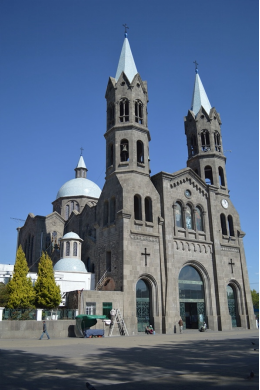
In Cuauhtémoc central street you’ll find this attractive church that was built almost at the same time as Apizaco was drawn on the map, when the Mexico-Veracruz railway route was inaugurated.
This was the territory's first religious temple. The quarry stones for its foundations were brought from the nearby Xaltocan and Santa Úrsula towns by the same settlers on mules and carts.
34 years took the neo-Gothic church’s construction with marble floors. There are those who say that it’s inspired by the Sagrada Familia expiatory temple in Barcelona.
Three naves hand-carved by artisans from the community conform the building, as well as a 21 meters lobby and a 35.5 meters high Venetian granite crowning dome. Its imposing towers reach 50 meters high. The Carrara marble altar is another gem as being framed by columns of the same material brought from Tepeaca.
There’s a very peculiar passage referring to this church: among the construction donors was the famous “Mimo de Mexico”: Mario Moreno Cantinflas, invited to hold a bullfighting festival in Apizaco for raising funds, especially to make the towers. He even donated part of the temple’s currently decorating chandeliers.
https://www.visitmexico.com/en/tlaxcala/apizaco/basilica-de-la-misericordia-basilica-of-mercy
Casa de Piedra Museum
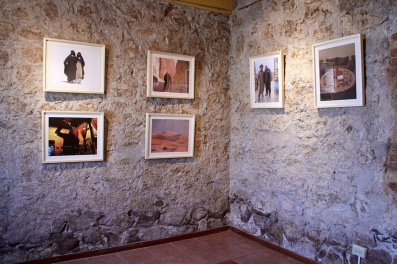
On Morelos avenue is a site for the better understanding of the city’s origin due to the railway route that crossed these lands. So, you shouldn’t miss visiting the Museo Casa de Piedra, on the side of the railway station. This place—conformed by the station, special services, train office, cellar and roundhouse—is also worth visiting to admire its 20s original architecture.
The 1916 building had the original function to be the Ferrocarriles Nacionales de México’ workers headquarters, but in 2001 it was inaugurated as a new museum whose purpose is for the visitor to learn about the intricate history of the railroad and Apizaco.
Among the objects on display throughout the 12 exhibition rooms, there are historical documents related to the town’s founding such as the appointment of the first mayor in 1892, the original plans for the Basilica de la Misericordia construction or the city shield designed in 1966 by the master Cutberto Escalante.
Centro de las Artes Ex Fábrica de Hilados, Tejidos y Estampados San Luis (Arts Center Ex-Factory of Yarns, Fabrics and Prints San Luis)
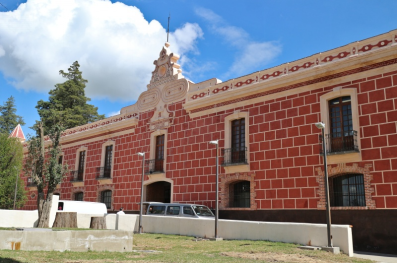
The last great bastion of Apizaco cultural and historical identity is its beautiful textile tradition. Spanish introduced woolen weaving in this area when several farms dedicated to raising sheep were established. So, visiting this building of partition and adobe with white-flattened and Catalan-roof on Fernando Solana St, in San Luis Apizaquito town, is a must.
This site originally served as a wheat mill that belonged to the Frenchman Simón Steffani, although due to the town's geographical location it became the most important cotton textile production center. Later, Mr. Ángel Solana acquired this land in 1899 to build the Fábrica de Hilados, Tejidos y Estampados San Luis (San Luis cotton yarn and fabric factory).
At the beginning it had only ten looms, but in full swing it had up to 400, in addition to installing electrical power that worked with water from the Hacienda San Diego Apatlahuaya waterfall. The factory operated until 1959, when it closed permanently.
Currently it is the Centro de las Artes de Tlaxcala, being one of the country’s largest and most modern, with a wide diversity of classes and workshops focused on the visual arts, music and dance.
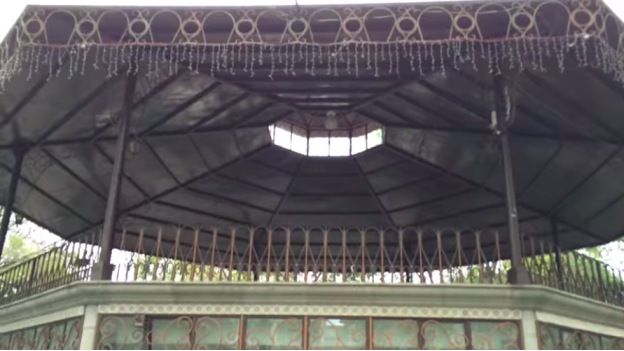
City of Apizaco Mexico
https://youtu.be/tje9FBR55rc
6. History
Prehispanic era
Nomadic hunters left testimony of their presence in Apizaco, almost 10 000 or 12 000 years ago, by means of a small retouched "flake", which in association with paleofauna was found by the archaeologist Rafael Abascal, in a site that is located just 8 kilometers southwest of the municipal seat. The flake was found in a fossiliferous layer that was shallower than the one that held the tip of the "clovis" projectile, discovered in San Juan Chiautzingo in the municipality of Santiago Tetla, of similar age.
The colony
The Apizaco region, like others in Tlaxcala, did not escape Spanish penetration from Puebla, which would later form huge latifundia, violating the initial prohibition that prevented the establishment of Spaniards in the lands of Tlaxcala. One way to get ranches, ranches and haciendas, was the method of "compositions", which represented the recognition of the possession of indigenous land by the Spanish, through fraudulent purchases that legalized the royal authority, in order to obtain resources for sustain the warfare in Europe.
Reform
On March 1, 1866, Guillermo Lloyd delivered his report on the advancement of the railway works, indicating that there was no problem in laying the rails from Apizaco to Mexico. He added that they could advance 2 miles a day, as long as the sleepers were delivered promptly. Guillermo Lloyd calculated that at the beginning of June the trains from Apizaco to Mexico could circulate, and the branch to Puebla, in August. The railway inaugurations would follow one after another. On September 16, 1869, President Benito Juárez inaugurated the Mexico-Apizaco-Puebla line.
The Porfiriato
The defeat suffered by the Lerdístas forces in the battle of the Tecoac hacienda did not modify the ascending path of Apizaco, since Miguel Lira y Ortega again occupied the governorship. During his Apizaco administration, apart from constituting the head of the municipality of Barrón Escandón, it was also the head of the District of Cuauhtémoc. For his part, when Colonel Prospero Cahuantzi took over the governorship of the state, in 1894 he reported to the state Congress that the construction of the bridge over the Ateneo River was being followed with enthusiasm in the aforementioned district and that the road to Apizaco, and the construction of the municipal trail, the Plaza de Armas and several wells for watering the trees that had been planted to be concluded.
Mexican Revolution
Not enough information has been found about anti-reelection clubs in Apizaco. Well, the railroad workers who traveled to the north or Mexico City, as well as the young people who participated in the military service, organized by General Bernardo Reyes, must have expressed some concerns, as happened throughout the Republic. But there is information and testimonies about national events, in which Apizaco was the scene and which have been described in the novel of the Mexican Revolution.
Contemporary age
The first people from Apizaque to attend the national changes were the railroad workers, who in the incipient babbling to confront the discrimination and marginalization to which the administrators of foreign companies had subjected them, formed the mutual associations with which they attended the nationalization of the railways at the end of the Porfiriato. On March 13, the Mutualista Héroe de Nacozari de Apizaco association was dissolved, transforming into the vigorous Section Number 3 of the National Union of Railroad Workers of the Mexican Republic (SNTFRM), in the great Convention that was held in Mexico City. The current city of Apizaco owes its origin to the Mexican Railroad and the vicissitudes through which its layout, construction and operation passed, led to the founding of the Apizaco station and to a large extent its subsequent development.
7.Contact Information

City Mayor: Julio César Hernández Mejía
Phone number: +52 (241) 418 0845
E-mail: presidencia@apizaco.gob.mx
Facebook: https://www.facebook.com/Juliohdzm
Twitter: https://twitter.com/JulioCesar_HdzM
Website: https://apizaco.gob.mx
Govt. Office Address: Boulevard 16 de Septiembre s/n, Colonia Centro, C.P. 90300, Apizaco, Tlaxcala, México
